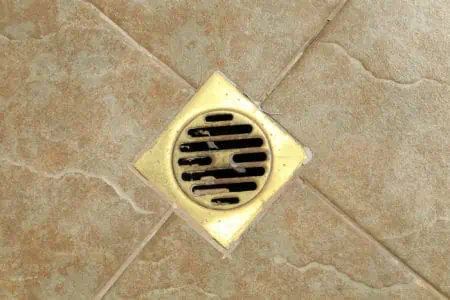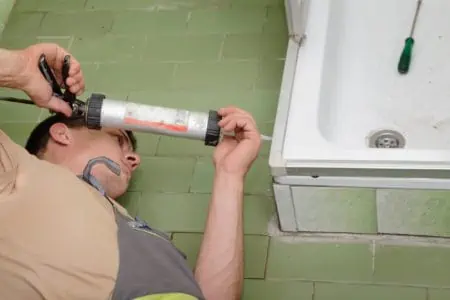Finding the right shower curtain is a challenge. Not only does it have to look good and match your taste and style, but it also has to be functional. Standard shower curtain sizes make it a bit easier, but there are still many elements that go into choosing the right shower curtain.
Here’s our take on standard shower curtain sizes.
Key Takeaways
- Standard shower curtain sizes: 70×70 inches, 70×72 inches, and 72×72 inches (most popular).
- Measure shower width from wall to wall, add 12 inches for the correct curtain width.
- Measure shower curtain height from the bottom of the curtain rail to the floor, subtract 10 inches.
- Choose the right material for your shower curtain, such as canvas, plastic, or polyester.
Standard Shower Curtain Size
Shower curtains come in all shapes and sizes, but there is a standard size that most bath and shower designers adhere to. The standard size is based on the average size of tubs and showers.
It has to cover a 60-inch bath entirely and have enough slack in the material that when it is fully closed, won’t feel taut. The accepted allowance is 12 inches.
Here are the 3 main shower curtain dimensions:
- 70 inches x 70 inches.
- 70 inches x 72 inches.
- 72 inches x 72 inches (this is the most popular size).
These measurements are intended to cover in-set tubs and won’t work for freestanding baths because you would need a curtain covering both sides.
For walk-in showers, a longer 78-inch length is more common because you don’t have the luxury of tub sides to fall back on.
What Size Shower Curtain Do You Need?
The size of the shower curtain depends on the size and shape of your bath or walk-in shower. But this is only half the story. The dimensions of your shower may not match the sizes of your shower curtain.
Each variant of shower and bathtub has standard dimensions. Here are the measurements by width and length in a handy table.
| Type | Dimensions (inches) |
| Popular standard shower size | 72 x 72 |
| Extra-wide bathtub | 84 x 74 |
| Shower stall | 54 x 78 |
| Extra-tall | 70 x 84 |
| Floor to ceiling shower | 72 x 96 |
Measuring Your Shower Curtain Width
To determine the width of your shower curtain, first, you need to measure the width of your shower stall from wall to wall. Make sure you add in the extra 12-inch allowance so that when you pull the curtain taut, it reaches and still has enough slack to create folds in the curtain.
It’s much more aesthetically pleasing and builds in the extra that you need to cover the shower base completely. If the curtain is too short in width, water will escape and cause staining and mold in other parts of your bathroom.
Measuring Your Shower Curtain Height
When it comes to measuring the height, it is a little different. Don’t measure from the ceiling to the floor, as this will leave you with too much material and cause moisture problems. Instead, measure from the bottom of the shower curtain rail to the floor.
This helps you take into account the types of curtain rings you want to use. You should also subtract about 10 inches from the measurement to take into consideration the height of the shower.
Overly long shower curtains can cause mold and mildew because they never get the chance to air-dry. Get the length wrong, and it could mean you will be replacing your shower curtain sooner than you think.
Measuring a Shower Curtain for a Freestanding Shower or Tub
Sizing a shower curtain for a freestanding tub or shower stall is pretty straightforward. The height measurement is the same because you still don’t want your shower curtain draping on the floor, causing mold and mildew problems.
Instead of sizing the curtain from wall to wall to get the width, measure the entire rim of the tub as this is the area to get exposed. Don’t forget to add on the standard 12-inch allowance so that the curtain hangs neatly with enough pleats.
Top Tip
The Best Material for a Shower Curtain
With so many choices, selecting the shower curtain material that’s right for you is crucial. Each material reacts differently to water and brings a particular type of flair to your bathroom styling.
Now that you’ve sized the shower curtain, let’s look at your material options.
Canvas
Canvas is an excellent choice thanks to its water resistance and ability to hold its shape when it gets wet. It doesn’t wrinkle when it dries, like other materials, and it feels substantial. Canvas shower curtains can be expensive, so make sure you shop for the best deals.
Also, while canvas deals with water well, it is not 100 percent waterproof, so make sure you keep a shower curtain liner between the shower curtain and the showerhead. That way, you keep the curtain looking better for longer, and it doesn’t perish prematurely.
Plastic
Plastic sounds like an obvious material to use. It’s water-resistant, lightweight, and long-lasting. It can seem a little bit on the “budget” end of the spectrum, but a plastic shower curtain will serve you well, and they do come in hundreds of color and style variants.
Plastic is also better at dealing with steam and never wrinkles when dry. If you buy a clear or white curtain, you will eventually see evidence of watermarks and clouding as the material becomes more brittle.
This is easily solved with regular cleaning to keep the tide marks at bay.
Polyester
Polyester shower curtains look and feel a lot like canvas ones. They are heavy, luxurious, and sturdy. If you want a shower curtain that’s easy to clean, polyester could be your best choice.
The other advantage of polyester is that they come in many patterns and colors.
Where To Hang a Shower Curtain Rod
There is no template or rule about the height you should hang your shower curtain rod, but there are a few guidelines.
When measuring the curtain rod’s height, make sure that the curtain hangs no more than an inch or so from the ground. As we’ve said before, too much material in contact with the floor creates moisture problems like mold and mildew. It’s also a trip hazard.
They also get in the way when you are cleaning the bathroom. It’s also important that when you are placing the curtain rod, you measure the curtain from the bottom of the rail to take into account the curtain rings.
Top Tip
With a standard 72-inch curtain length, adding about 3 inches should help you get an idea of the rod’s ideal height, meaning the curtain rail should be between 75 and 77 inches in height.
Shower curtains vary in length, so make sure you have checked the measurements before cutting the rod and deciding where to drill the holes. As we’ve said, the type of hooks you use adds extra length, so take this into account when making your measurements.
When fitting permanent brackets, consider using a tension rod first to get the exact height. Then you can mark the wall and position the bracket without predrilling.
Does the Shower Curtain Go Inside the Tub?
The answer is three-fold. If you are bathing in the tub, the shower curtain should hang on the outside. You wouldn’t want it draped in the water, getting wet, and restricting your movement in the bath.
If you have a curtain liner, the curtain should be on the outside while the liner hangs inside the tub, protecting the curtain and your bathroom floor from water damage. If you have a waterproof shower curtain, this should definitely go inside the tub. If not, all the water runs down the curtain and onto the floor.
Standard Shower Curtain Size FAQs
The Final Curtain
Shower curtains are not only functional, protecting your bathroom floor from water damage, but they also enhance the style of your bathroom, adding a much-needed splash of flair to an otherwise plain white room.
However, while it may look good, it needs to fit your bathroom or shower stall to do its job effectively.












